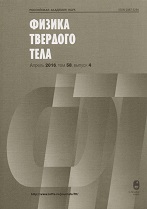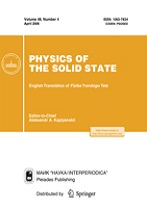|
|
Физика твердого тела, 2021, том 63, выпуск 6, страница 747
(Mi ftt10144)
|
 |
|
 |
Эта публикация цитируется в 2 научных статьях (всего в 2 статьях)
Диэлектрики
Effect of sodium iodide dopant concentration on the electrical behavior of AgPO$_3$ glassy networks
A. Shaheena, S. Qabajeha, Z. Khattaria, J. Al-Jundia, A. Aqilia, F. Salmanb
a Department of Physics, Faculty of Science, The Hashemite University, P.O. Box, Zarqa, Jordan
b Department of Physics, University of Banha, Banha, Egypt
Аннотация:
The ionic and dielectric behavior of (AgPO$_3)_{(1-x)}$–NaI$_x$ ($x$ = 0, 0.02, 0.04, $\dots$, 0.14) systems were tested in the frequency range of 1–10$^6$ Hz at different temperatures using impedance spectroscopy technique. Samples were prepared using the melt quenching method to obtain the desired ratios between NaI and AgPO$_3$. Results of impedance measurements showed a switching from resistive-like (at low frequency) to capacitive-like (at higher frequency) behavior with a single relaxation peak that shifts to higher frequency with increasing either the temperature or the dopant concentration. In addition, the Nyquist plots showed a decrease in the values of the bulk resistance of the samples with increasing temperature and dopant concentration. The measured AC-conductivity shows a cross-over at frequency $f>10^5$ Hz. The conductivity shows an increase as function of temperature regardless the frequency range and it is almost constant at low frequency up to the crossover frequency, in addition to that, the power law dispersive behavior was also observed at higher frequency ($f>10^5$ Hz). The DC-conductivity can be explained in terms of silver ions successful diffusion process that take place due to the applied alternative electric field. On the other hand, the diffusion controlled relaxation (DCR) model can be used to explain the power law conductivity. Finally, the values of the activation energy calculated from the linear plot of Arrhenius equation were found to decrease with the dopant concentration from 0.65 eV at zero concentration to 0.36 eV at 14% concentration.
Ключевые слова:
impedance, AC-conductivity, NaI, ionic compound, dielectric constant.
Поступила в редакцию: 27.01.2021
Исправленный вариант: 09.02.2021
Принята в печать: 11.02.2021
Образец цитирования:
A. Shaheen, S. Qabajeh, Z. Khattari, J. Al-Jundi, A. Aqili, F. Salman, “Effect of sodium iodide dopant concentration on the electrical behavior of AgPO$_3$ glassy networks”, Физика твердого тела, 63:6 (2021), 747; Phys. Solid State, 63:6 (2021), 914–923
Образцы ссылок на эту страницу:
https://www.mathnet.ru/rus/ftt10144 https://www.mathnet.ru/rus/ftt/v63/i6/p747
|


| Статистика просмотров: |
| Страница аннотации: | 44 | | PDF полного текста: | 19 |
|





 Обратная связь:
Обратная связь: Пользовательское соглашение
Пользовательское соглашение
 Регистрация посетителей портала
Регистрация посетителей портала Логотипы
Логотипы








 Цитирование в формате
Цитирование в формате 
